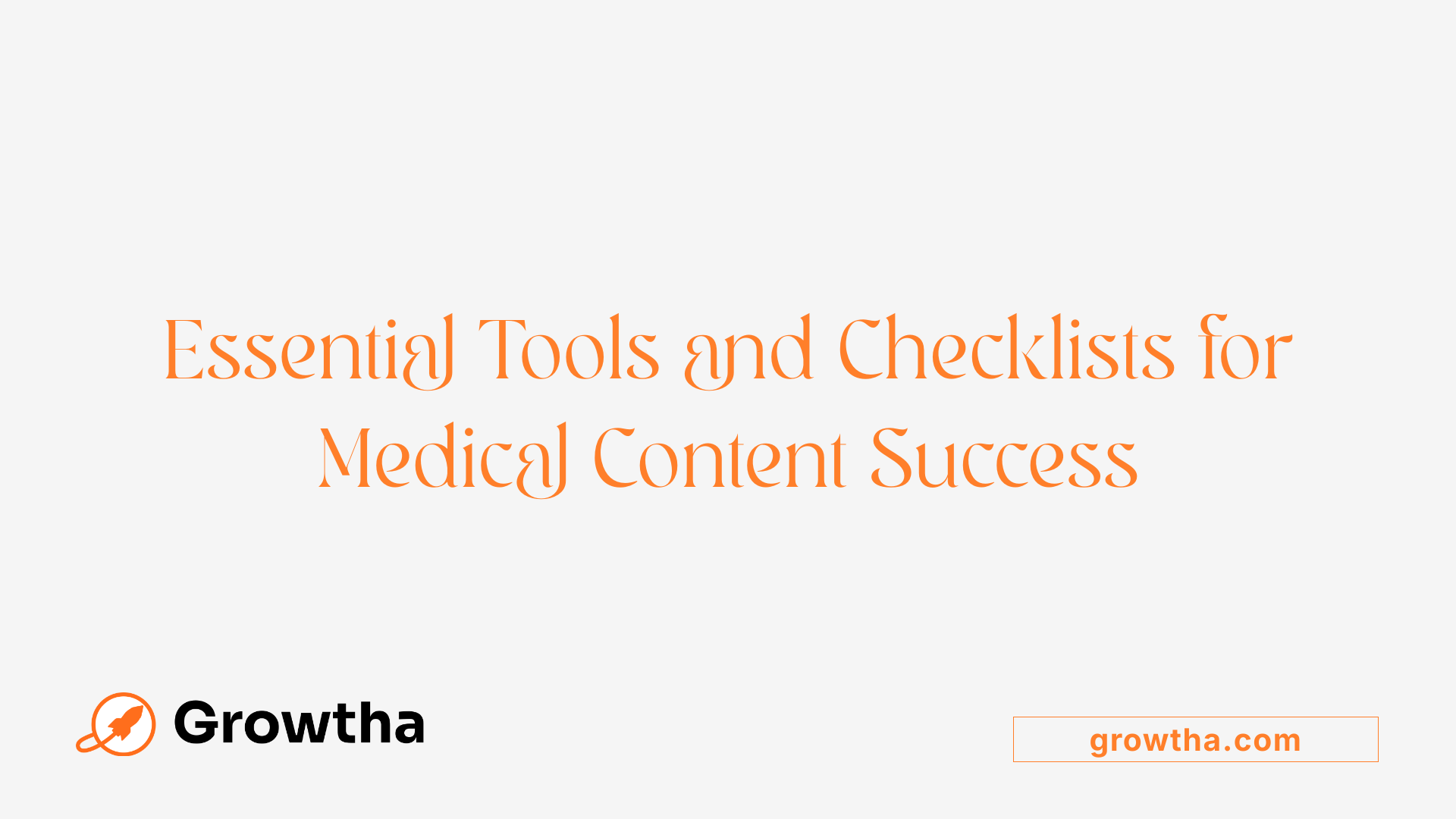How to Use Content Audits to Improve Medical Websites
Enhancing Healthcare Websites Through Strategic Content Audits


How to Use Content Audits to Improve Medical Websites
Understanding the Power of Content Audits in Healthcare
In an increasingly digital landscape, healthcare organizations rely heavily on their websites to inform, engage, and convert visitors into patients. Conducting systematic content audits is a vital step in ensuring that these websites effectively serve their audiences. This article explores comprehensive strategies, tools, and best practices for deploying content audits to optimize medical website performance, improve SEO, guarantee compliance, and foster trustworthiness.
Defining the Purpose of a Content Audit in Healthcare

What is a content audit?
A content audit is a comprehensive review and evaluation of all the content on a healthcare website. It involves cataloging pages, assessing their quality, relevance, and effectiveness in delivering the right information to patients and stakeholders. This process ensures content aligns with organizational standards and meets user needs effectively.
Goals of a content audit for medical websites
In healthcare, the main goals of conducting regular content audits are to verify accuracy, improve clarity, and enhance patient engagement. It helps identify outdated, duplicate, or low-quality information that needs updates or removal. Audits also evaluate how well content supports search engine optimization (SEO), ensuring the site maintains visibility and authority. Moreover, this process assists in aligning content with strategic objectives, such as promoting specific services or emphasizing patient-centered care.
Benefits of regular content evaluation
Consistently reviewing website content offers numerous advantages. It enhances user experience by ensuring information is accurate, accessible, and easy to find. Regular audits support SEO efforts, increasing online visibility and driving more traffic. They also build trust by providing credible, transparent, and up-to-date information, which is essential in healthcare. Additionally, content audits help streamline resources, prevent redundancy, and guide future content development to meet evolving patient needs.
What is the purpose of a content audit?
A content audit aims to identify and evaluate the existing content on a website to ensure it aligns with user needs and business goals. It involves assessing the quality, relevance, and effectiveness of the content to determine what is valuable and what may need to be updated or removed. Additionally, a content audit helps establish benchmarks for performance through methods like web analytics and usability studies. It also informs the development of personas and information architecture improvements, such as tree testing, to enhance content findability. Overall, the purpose of a content audit is to optimize website content for better user experience and achievement of strategic objectives.
Key Steps in Conducting a Content Audit for Medical Websites
What are the key steps to perform a content audit for a website?
A thorough content audit is essential for maintaining an effective healthcare website. It begins with clearly defining your goals—whether it's improving SEO, enhancing user experience, or addressing compliance needs.
The next step involves gathering all existing content assets. This can be done using spreadsheets or specialized tools such as content inventory software. Organize content by criteria like page type, application, audience, and format.
Once assets are collected, evaluate each piece's quality and relevance. Consider whether the content is accurate, up-to-date, and aligned with your organization’s voice and style. Assess its effectiveness by analyzing performance metrics such as page views, bounce rates, engagement, and conversion data from analytics platforms like Google Analytics.
Qualitative review is equally important, focusing on whether the content addresses patient needs, is easy to understand, visually appealing, and compliant with standards. Use site crawlers like Screaming Frog or SEMrush to identify technical issues, broken links, and SEO gaps.
Identify areas where content underperforms or is outdated. Spot gaps in information that could enhance user experience or SEO. Prioritize improvements based on potential impact.
Develop a strategic action plan that includes updating, consolidating, or deleting content. Assign responsibilities for each task and establish a timeline.
Finally, set up ongoing monitoring to evaluate the effectiveness of changes over time. Regular audits (every 3-4 months) help track progress, adapt to new trends, and ensure continuous improvement.
Tools and Checklists for Effective Medical Content Audits
 Conducting thorough content audits on healthcare websites is essential to ensure accuracy, compliance, and effectiveness. Utilizing the right tools and checklists helps identify issues and guide improvements systematically.
Conducting thorough content audits on healthcare websites is essential to ensure accuracy, compliance, and effectiveness. Utilizing the right tools and checklists helps identify issues and guide improvements systematically.
SEO Tools: Platforms like Semrush and Screaming Frog are instrumental in analyzing on-page SEO elements, identifying broken links, duplicate content, and technical site structure issues. Semrush offers insights into keyword performance and backlinks, while Screaming Frog crawls the entire site to reveal technical SEO problems.
Analytics Platforms: Google Analytics and Search Console provide performance data such as traffic sources, user behavior, and search rankings. Google Search Console also offers tools for monitoring indexing status and site health, indispensable for ongoing SEO management.
Content Quality Assessment: Tools like Grammarly assist in checking readability and grammatical accuracy, ensuring content is clear and professional. Copyscape can detect duplicate content, helping maintain originality and integrity.
Accessibility and Compliance Checks: Platforms such as AudioEye and the Wix Accessibility Wizard evaluate whether content meets ADA standards, providing reports on accessibility issues to make websites usable for all users.
Content Audit Checklists: Authoritative sources like the Agency for Healthcare Research and Quality (AHRQ) provide comprehensive checklists focusing on patient safety, content accuracy, and ease of navigation. These checklists serve as guides for a structured review process, ensuring all critical content aspects are evaluated.
Summary Table of Tools and Checks:
| Tool/Platform | Purpose | Additional Features |
|---|---|---|
| Semrush | SEO analysis | Keyword tracking, backlink analysis |
| Screaming Frog | Technical site crawl | Detects broken links, redirects |
| Google Analytics | User behavior | Traffic sources, bounce rate |
| Google Search Console | Site health | Indexing, security issues |
| Grammarly | Content quality | Grammar, clarity |
| Copyscape | Duplicate content | Originality checking |
| AudioEye | Accessibility | Automated compliance checks |
| AHRQ Checklists | Content review | Patient safety, usability |
Regularly leveraging these tools in combination with established checklists allows healthcare organizations to perform comprehensive audits. This proactive approach helps identify gaps, prioritize updates, and ensure the website remains trustworthy, user-friendly, and optimized for both search engines and patients.
Performing systematic content reviews with these resources not only enhances SEO performance but also supports compliance with healthcare regulations, ultimately contributing to better patient engagement and safety.
Aligning Content Audit Strategies with SEO and User Engagement Goals

How do content audits contribute to SEO and website performance strategies?
Content audits are essential for optimizing healthcare websites by systematically reviewing all existing content. They help identify pages that underperform in search rankings, uncover technical issues like broken links or slow load times, and reveal content gaps that could attract more visitors. By analyzing performance metrics such as keywords, bounce rates, and engagement levels, audits provide concrete insights to enhance relevance and visibility.
These evaluations enable targeted improvements, such as incorporating relevant keywords, restructuring content for better readability, and updating outdated information. Updating and optimizing content based on audit findings greatly boosts search engine rankings and enhances user experience, guiding visitors more effectively through the site.
Regular content audits also uncover new opportunities for SEO, such as employing structured data, optimizing local SEO factors like Google My Business profiles, and ensuring content aligns with search intent. They assist in prioritizing which pages to update, delete, or repurpose, helping maintain a dynamic and highly effective website.
Overall, content audits are the backbone of a strategic SEO and performance plan. They provide the data-driven foundation needed to continuously improve content quality, increase organic search traffic, and better meet the needs of healthcare consumers. This ongoing process ensures the website remains competitive, trustworthy, and aligned with both search engine algorithms and user expectations.
| Aspect | Benefits | Implementation Tips |
|---|---|---|
| SEO Optimization | Improves rankings, increases visibility, attracts more traffic | Integrate keywords, improve metadata, structure content clearly |
| User Engagement | Enhances user experience, reduces bounce rate, builds trust | Assess content relevance, optimize navigation, include CTAs |
| Technical Health | Ensures website functions properly and is accessible | Use tools like Siteimprove, fix broken links, enhance mobile responsiveness |
| Local SEO Strategies | Boosts local search presence, attracts nearby patients | Optimize Google Business Profile, encourage reviews |
| Analytics and Continuous Improvement | Guides ongoing strategy refinement | Regularly review metrics, update content based on data insights |
Performing consistent content audits ensures healthcare websites stay relevant, authoritative, and user-friendly. By leveraging detailed analysis and technological tools, organizations can foster a powerful online presence that not only ranks well in search engines but also provides meaningful, accessible information to patients and caregivers alike.
Maintaining Content Compliance and Authority in Healthcare Websites
How do content audits help ensure healthcare content is compliant and accurate?
Conducting regular content audits is vital for healthcare organizations aiming to uphold legal and regulatory standards. These audits serve as a comprehensive review process, ensuring that all website content, including service line pages, provider profiles, and location information, aligns with industry regulations, such as HIPAA and specific medical device policies.
During an audit, content is scrutinized for medical accuracy, credibility, and relevance. This involves verifying facts, updating outdated information, and ensuring citations come from trusted, reputable sources. By doing this, organizations can prevent the dissemination of misinformation, which is critical given the high stakes involved in healthcare communication.
A structured content assessment also evaluates whether the language used complies with legal standards related to patient privacy, informed consent, and advertising regulations. This process guarantees that content remains transparent, trustworthy, and aligned with organizational standards.
Why is medical accuracy and credibility so important?
Accurate, credible content fosters trust between healthcare providers and their patients. When websites showcase truthful and up-to-date information, patients are more likely to make informed decisions about their health. Moreover, authoritative content, created or reviewed by qualified healthcare professionals, enhances a website’s reputation and search engine rankings.
Using professional reviews and trustworthy sources not only boosts content credibility but also helps meet Google’s E-E-A-T (Experience, Expertise, Authority, Trustworthiness) guidelines. This is crucial for ranking higher in healthcare search results and for establishing a reliable online presence.
How can consistent messaging and branding be maintained?
Maintaining a uniform voice, tone, and style across all content ensures the organization’s branding remains clear and professional. During content audits, it's common to identify inconsistencies or deviations that may dilute the brand message.
Implementing a style guide and training content creators helps preserve messaging consistency. Regular audits ensure that content aligns with this guide, reinforcing branding and making the experience seamless for users.
What role does trust in sources and professional review play in content quality?
Citing reputable sources such as peer-reviewed journals, government health agencies, and leading medical institutions enhances the trustworthiness of healthcare content. Displaying professional credentials, certifications, and reviews from healthcare experts further builds confidence.
Utilizing trusted sources and professional reviews during content creation or updating processes helps organizations communicate authority and reliability. This approach also differentiates them from disreputable competitors, fostering patient trust and engagement.
| Aspect | Details | Benefits |
|---|---|---|
| Content Compliance | Adheres to legal standards, privacy laws, and regulations | Protects against legal risks and maintains credibility |
| Medical Accuracy | Information reviewed by qualified professionals | Builds trust and improves patient decision-making |
| Credibility & Trustworthiness | Use of reputable sources, certifications, and citations | Enhances reputation and SEO rankings |
| Consistent Branding | Uniform messaging, voice, and style across pages | Reinforces organizational identity and professionalism |
| Regular Audits | Schedule for ongoing review, updates, and improvements | Ensures content remains relevant, accurate, and compliant |
Keeping content compliant and credible requires a systematic approach, involving regular audits, proper source citation, and professional review. This effort not only complies with standards but also enhances overall trust, user experience, and search engine performance, ultimately supporting organizational authority in the healthcare industry.
Integrating Content Audits into Broader SEO and Performance Strategies
 Content audits are essential components of a comprehensive SEO and website performance management plan. They systematically analyze existing content to identify areas needing improvement, including underperforming pages, technical issues, and missing information.
Content audits are essential components of a comprehensive SEO and website performance management plan. They systematically analyze existing content to identify areas needing improvement, including underperforming pages, technical issues, and missing information.
Aligning content audits with SEO practices involves reviewing metadata, keywords, and structured data to ensure they support ranking efforts. Optimizing title tags, meta descriptions, and schema markup based on audit insights can significantly enhance search engine visibility and click-through rates.
Using the data obtained from audits, teams can update and optimize content for better engagement. This includes refreshing outdated information, restructuring content to improve readability, and embedding relevant keywords naturally within the text. These adjustments help elevate content relevance and authority, which are crucial for improving rankings.
Insights from audits guide ongoing improvements. Regular evaluations help prioritize content creation, updates, or removal. Utilizing tools like Google Search Console, Analytics, and structured data assessments allows continuous monitoring and fine-tuning of content strategies.
Tracking performance after implementing changes is vital. Metrics such as page traffic, bounce rate, conversion rate, and keyword rankings should be closely followed. This feedback loop enables organizations to measure the success of their optimization efforts and make data-driven decisions for future actions.
Effective integration of content audits into SEO strategies results in increased organic visibility, better user engagement, and ultimately, higher patient acquisition and retention rates in healthcare settings. Regularly scheduled audits—every 3-4 months—ensure the website remains responsive to evolving search algorithms and patient needs, securing a competitive edge.
Summary and Continuous Improvement Through Content Auditing
Why are regular content audits essential?
Conducting routine audits of website content is vital for maintaining accuracy, relevance, and effectiveness. In healthcare websites, regular reviews ensure information is up-to-date, compliant with regulations, and aligned with organizational goals. Audits help identify outdated, duplicate, or low-quality material, enabling organizations to update, delete, or consolidate content. This process enhances user experience, boosts search engine optimization (SEO), and reinforces credibility.
How to develop a content management cycle?
A structured content management cycle involves systematically organizing all existing content—covering the past 18 months or more—and categorizing it based on criteria such as title, type, application, audience, sales messages, and location. This prepares the ground for effective analysis and updates. Using tools like spreadsheets, CMS analytics, and inventory software allows teams to monitor content health, analyze performance, and identify opportunities for improvement. Scheduling audits every 3-4 months keeps content fresh and aligned with evolving patient needs and industry standards.
Creating a content improvement plan
Post-audit, organizations should develop a comprehensive content improvement plan. This involves prioritizing updates—revising, deleting, or creating new pages—and assigning responsibilities to content creators, editors, and IT teams. The plan should include technical updates for SEO, such as refining metadata and structured data markup, and qualitative enhancements like improving readability and visual support. Ensuring content aligns with voice, tone, and personas based on real patient insights enhances engagement and trust. Incorporating emotional insights can make content more relatable and effective.
How to measure success and iterate?
Evaluating the impact of content updates involves analyzing performance metrics like website traffic, engagement levels, bounce rates, conversions (such as appointment bookings), and SEO rankings. Tools like Google Analytics, Search Console, and heatmaps provide actionable data. Setting clear KPIs and regularly monitoring allows organizations to measure progress and identify areas needing further refinement. An iterative approach—making continuous adjustments based on data—ensures ongoing content relevance, higher patient satisfaction, and better site performance.
| Aspect | Actions | Expected Outcome |
|---|---|---|
| Regular audits | Schedule every 3-4 months; use tools for site crawling and tracking | Maintains content accuracy and SEO health |
| Content management cycle | Organize, categorize, analyze, and update content systematically | Streamlines content updates and resource efficiency |
| Improvement planning | Prioritize, assign tasks, update metadata, enhance visuals | Creates engaging, compliant, authoritative content |
| Performance measurement | Use analytics tools to monitor KPIs and user interactions | Tracks progress and guides ongoing improvements |
Best practices for content management and optimization in healthcare websites include selecting a secure and compliant CMS that supports easy content management across multiple sites. Regular audits and reviews help ensure content remains accurate, authoritative, and user-focused, bolstering trust and credibility. SEO strategies such as keyword research, metadata optimization, structured data, and backlinks are crucial for visibility. Accessibility, mobile-friendliness, and transparent practices enhance user experience and trust. Implementing a feedback mechanism and leveraging analytics enable continuous improvements, keeping healthcare websites effective and compliant.
Maximizing Content Strategy for Optimal Healthcare Website Performance
Regularly conducting comprehensive content audits is essential for maintaining and enhancing the effectiveness of healthcare websites. These audits support improvements in SEO, content accuracy, user engagement, and compliance, ultimately bolstering trust and credibility. By leveraging the right tools, following best practices, and integrating audit insights into broader performance strategies, healthcare organizations can ensure their websites meet evolving patient needs while achieving strategic marketing and operational goals. Continuous evaluation and iteration foster ongoing growth, resource efficiency, and enhanced patient experience, positioning healthcare websites as authoritative sources in their digital health journeys.
References
- How to improve healthcare web content with targeted audits
- Content Audit Best Practices for the Medical Device Industry - Prolifiq
- How to Conduct a Content Audit | YaleSites
- Healthcare Content Audit: 6 More Benefits for Your Organization
- How Can Doctors Conduct Content Audits for Improved SEO?
- How to Conduct a Content Audit + Template, Checklist
- How to perform a content audit the right way - Contentoo
- How to Maximize Website Traffic with a Content Audit ... - Stamats







